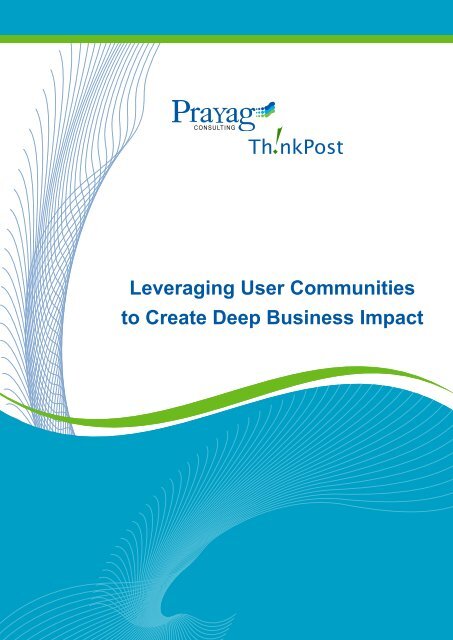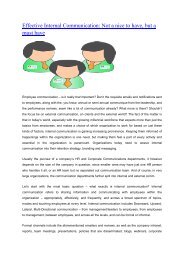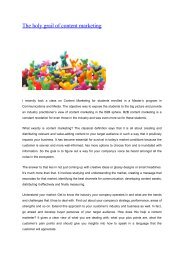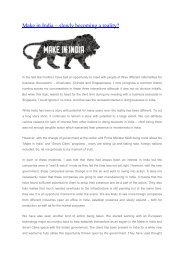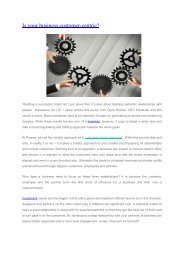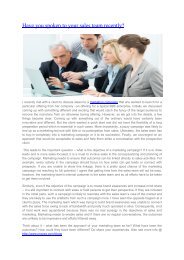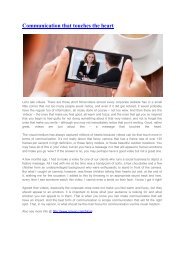Leveraging User Communities to Create Deep Business Impact
User communities, per se, are not a new phenomenon. They have existed in the real world for years, but in more passive forms. Wherever there are products, there are users, and inevitably users would get together to discuss their experiences with the product. Housewives deriding the local grocer, students comparing the attributes of their pens, and even office-goers arguing over the usability of a particular brand of laptop are all user communities in their most basic form.
User communities, per se, are not a new phenomenon. They have existed in the real world for years, but in more passive forms.
Wherever there are products, there are users, and inevitably users would get together to discuss their experiences with the
product. Housewives deriding the local grocer, students comparing the attributes of their pens, and even office-goers arguing
over the usability of a particular brand of laptop are all user communities in their most basic form.
You also want an ePaper? Increase the reach of your titles
YUMPU automatically turns print PDFs into web optimized ePapers that Google loves.
!<br />
Th nkPost<br />
<strong>Leveraging</strong> <strong>User</strong> <strong>Communities</strong><br />
<strong>to</strong> <strong>Create</strong> <strong>Deep</strong> <strong>Business</strong> <strong>Impact</strong>
<strong>User</strong> communities, per se, are not a new phenomenon. They have existed in the real world for years, but in more passive forms.<br />
Wherever there are products, there are users, and inevitably users would get <strong>to</strong>gether <strong>to</strong> discuss their experiences with the<br />
product. Housewives deriding the local grocer, students comparing the attributes of their pens, and even office-goers arguing<br />
over the usability of a particular brand of lap<strong>to</strong>p are all user communities in their most basic form.<br />
Even in these loose forms, user communities were able <strong>to</strong> create some impact on products and manufacturers. Peers<br />
were influenced in tech hardware buying decisions, the local grocer’s business might have suffered from housewives’ tales of<br />
ants in the lettuce. This impact, however, was on a rather small scale.<br />
In the internet age, virtual communities and users are able <strong>to</strong> make their presence felt in a much bigger way. And <strong>to</strong>day, with<br />
the advent of Web 2.0 led collaboration, virtual user communities are stronger than ever. Never before have users wielded so<br />
much power. <strong>Business</strong>es have duly taken notice of this and are learning how <strong>to</strong> leverage the power of these virtual communities<br />
for their own benefit.<br />
One of the first companies <strong>to</strong> effectively utilize this power was Propellerhead Software, a developer of computer-controlled<br />
musical instruments including <strong>to</strong>ols for sound production,<br />
processing and recording. In 1999, Propellerhead launched<br />
Propellerhead recognized<br />
ReBirth, a software for sound processing and recording. The<br />
the potential in co-creation<br />
product code was initially unavailable <strong>to</strong> users. An impromptu<br />
and tapped it effectively.<br />
user community was formed on the Internet, for users of<br />
the product, <strong>to</strong> share tips and queries. But very soon, this<br />
community became the hub for something else. A group of<br />
computer-savvy members began <strong>to</strong> collaborate <strong>to</strong> try and<br />
hack in<strong>to</strong> the product’s source code. This process <strong>to</strong>ok 6-8 months with numerous users contributing <strong>to</strong> the effort.<br />
Finally, when the product had been successfully hacked, users began <strong>to</strong> create their own personalized versions with<br />
cus<strong>to</strong>m graphic designs and sound samples. The Propellerhead management, though surprised at the development,<br />
responded positively. They realized that they would be able <strong>to</strong> benefit from such product innovations, with more variety<br />
added by responsible users.<br />
This incident subsequently triggered the opening up of parts of their product code <strong>to</strong> users interested in modifying the<br />
product – the company even began encouraging users <strong>to</strong> send in cus<strong>to</strong>mized versions <strong>to</strong> them for review. Co-created<br />
updates of ReBirth were released in the market and these sold fast.<br />
The Propellerhead example highlights the power of user communities and the necessity for a business <strong>to</strong> recognize<br />
opportunities for furthering business objectives. It may be argued that Propellerhead <strong>to</strong>ok a gamble in encouraging the<br />
‘hackers’ instead of acting against them, but they were able <strong>to</strong> distinguish opportunity from threat and this eventually paid<br />
off.<br />
This paper will investigate the ways in which businesses can similarly utilize such communities <strong>to</strong> their advantage, as<br />
Propellerhead did. Along the way, we will discuss this in the context of implemented examples, including some from the<br />
Indian context.<br />
<strong>User</strong> <strong>Communities</strong> for Brand Building<br />
www.prayag.com
<strong>User</strong> <strong>Communities</strong> for Brand Building<br />
The Internet as a medium is designed for accessibility and comprehensiveness. Virtual communities further exemplify these<br />
qualities and, hence, many businesses regard firm-hosted user communities as an ideal medium for improving reputation and<br />
brand image. An easily accessible firm-hosted user community, providing a wide range of post-sales support options for its<br />
product, can go a long way in projecting the company as user-friendly and improve its reputation.<br />
Also, user feedback (positive or negative) on internet communities affects the perception of the brand, and can help companies<br />
recognize the pros and cons of its product, and where it stands with respect <strong>to</strong> competition. If implemented tactfully, a firm-hosted<br />
community can provide a feeling of involvement which adds <strong>to</strong> cus<strong>to</strong>mer satisfaction in using a product. The main incentive for<br />
someone <strong>to</strong> join a fan club is a similar sense of involvement. This is the kind of feeling firms can hope <strong>to</strong> recreate through virtual<br />
communities.<br />
An example, in this context, is the firm-hosted social networking<br />
site ‘Gang of Girls’, set up by Unilever’s Sunsilk shampoo. Sunsilk<br />
encourages all its users <strong>to</strong> get <strong>to</strong>gether on the site and discuss<br />
product use, hair care, beauty tips etc. The site has been marketed<br />
as a network for ‘girl bonding’ and looked <strong>to</strong> improve Sunsilk’s brand<br />
image among its target market of female youth.<br />
With Gang of Girls, Sunsilk<br />
was able <strong>to</strong> channel the<br />
appeal of ‘girl bonding’ <strong>to</strong><br />
boost its brand image.<br />
Another innovative branding strategy, focused around user<br />
involvement, is that of MTV India. MTV India has taken advantage<br />
of the considerable Indian presence on social networking sites such<br />
as Orkut (India is the second most listed nationality after Brazil)<br />
and Facebook. An MTV Webmaster creates and moderates <strong>to</strong>pical<br />
communities on Orkut and Facebook for MTV’s reality shows such<br />
as Roadies. <strong>User</strong> feedback, comments and suggestions are actively<br />
encouraged on these communities.<br />
The company used the community <strong>to</strong> track the popularity of its<br />
shows - as the majority of Indians on Orkut and Facebook are in<br />
the age group 15-25, this corresponds with the age of MTV’s target<br />
audience. Using a community was, in a sense, a perfect media fit<br />
for MTV.<br />
The online branding strategy of<br />
MTV has been highly successful.<br />
MTV was able <strong>to</strong> capitalize<br />
on the popularity of reality<br />
entertainment among its target<br />
audience and increase its television ratings<br />
significantly. Plus, the fit between its target<br />
group and social networking crowd resulted<br />
in a successful social media strategy <strong>to</strong>o.<br />
The success of this strategy in creating buzz<br />
around ‘Roadies’ has encouraged MTV <strong>to</strong><br />
implement similar online branding campaigns<br />
for shows like Splitsvilla <strong>to</strong>o.<br />
In both these examples, the companies essentially used online social networking <strong>to</strong> cast aside intermediaries, network, and<br />
gather real feedback from end consumers. In MTV’s case, since Roadies was a television serial, they had an opportunity <strong>to</strong><br />
translate adverse feedback in<strong>to</strong> program/format changes if needed. That is the immediacy in impact of this new medium.<br />
<strong>User</strong> <strong>Communities</strong> <strong>to</strong> Further Core <strong>Business</strong> Objectives<br />
Training and Recruiting<br />
Among core business functions, training and recruitment departments have been among the biggest beneficiaries of the Internet.<br />
From remote tu<strong>to</strong>rials <strong>to</strong> online hiring, the web has created many usable and efficient business applications. In equal measure,<br />
<br />
www.prayag.com
these departments have been quick <strong>to</strong> harness the powers of Web 2.0 as well. From using LinkedIn for effective hiring <strong>to</strong><br />
communities for employee interaction, there are plenty of examples <strong>to</strong> look at.<br />
One of the more sophisticated examples is Second Life, a virtual platform for interviews and training. Here, Wipro claims <strong>to</strong> be the<br />
first Indian company <strong>to</strong> have a presence on Second Life in the<br />
form of an Offshore Development Center known as Innovation<br />
By becoming the first Indian<br />
Isle. The virtual campus has facilities like client engagement<br />
corporate presence on Second<br />
center, learning center, 3 floor ODC setup with cubicles,<br />
Life, Wipro was able <strong>to</strong> justify its<br />
security desk at the campus entrance gate, amphitheatre,<br />
reputation as a ‘thought-leader.’<br />
press announcements hall, basketball and volleyball courts,<br />
data center and a library. Wipro has the option <strong>to</strong> tie up with<br />
various academic organizations on Second Life <strong>to</strong> streamline<br />
its training and recruiting processes. The benefits are clear -<br />
saving time, reducing business costs and allowing businesses <strong>to</strong> reach out <strong>to</strong> employees all over the world.<br />
Cus<strong>to</strong>mer Servicing<br />
Firm-hosted user communities are an effective way <strong>to</strong> respond <strong>to</strong> cus<strong>to</strong>mers, while simultaneously using the interaction <strong>to</strong> create<br />
a knowledge pool for other users. Even in independent user-communities (those not regulated by a firm), more experienced<br />
users help new users by answering their queries and sharing their knowledge. This user-<strong>to</strong>-user servicing takes a significant<br />
burden off the post-sales support systems of the company and reduces their workload greatly.<br />
A good example of this is Hewlett Packard (HP), which has large independent user-communities such as Encompass (now<br />
amalgamated in<strong>to</strong> Connect). Such communities are global in nature and reduce the workload of HP service centers.<br />
Connect is a world-wide independent membership organization formed from the consolidation<br />
of former HP users groups, including Encompass, ITUG and HP-Interex EMEA. The community<br />
represents dedicated business technology professionals committed <strong>to</strong> helping users maximize<br />
their return on investment in HP products. It connects laymen and professionals who have<br />
a shared interest in HP’s products and technology services. Connect has also instituted a<br />
Community Voice programme by which it hopes <strong>to</strong> influence future HP products and services.<br />
www.prayag.com
Marketing<br />
Social networking communities have become the fulcrum for Web 2.0 based marketing strategies of many companies. Consumer<br />
goods companies use platforms such as YouTube <strong>to</strong> distribute viral ads <strong>to</strong> create buzz around their products. To promote “legal<br />
purchase” of music among college students and its iTunes s<strong>to</strong>re, Apple partnered with Facebook in 2006. As a back-<strong>to</strong>-school<br />
special, Apple gave away 250 million music samplers <strong>to</strong> Facebook college users. Marketing through social networking sites can<br />
provide a more targeted reach and is a cost-effective way for a company <strong>to</strong> boost product sales.<br />
Distribution<br />
<strong>User</strong> communities can be utilized <strong>to</strong> streamline distribution, especially when the user community is the distribution network as<br />
well. This works well when the service activation or delivery is done on-line.<br />
mGinger is a Bangalore-headquartered opt-in, permission-based SMS service, through which users become part of a target<br />
community by providing details about their interests. The<br />
user receives SMS advertisements corresponding <strong>to</strong> these<br />
The innovative services<br />
interests from advertisers belonging <strong>to</strong> the mGinger network.<br />
mGinger provides monetary rewards <strong>to</strong> its users for every<br />
provided by mGinger<br />
SMS they receive, as well as for those their referrals receive.<br />
are beneficial <strong>to</strong> both<br />
Hence, users are motivated <strong>to</strong> create, maintain and expand<br />
their communities on mGinger<br />
advertisers and consumers - demonstrating that<br />
user communities can be monetized.<br />
Portals like mGinger are beneficial <strong>to</strong> both producers and<br />
consumers - consumers are provided information on products<br />
specific <strong>to</strong> their interests, and producers can save significant marketing costs in advertising only <strong>to</strong> those interested, giving them<br />
a more targeted reach.<br />
Product Modification and Improvement<br />
The Propellerhead example clearly delineates the benefits firms can derive from user modification or ‘modding’. One industry<br />
which has embraced this, <strong>to</strong> its great benefit, is the computer games industry. Computer games released in the late 1990s<br />
were extensively modified by communities of users/hackers <strong>to</strong> suit their own needs. Possibly, the most notable case of this is<br />
that of Half-Life, a First Person Shooter computer game released in 1998. Valve, the crea<strong>to</strong>r of Half-Life, decided <strong>to</strong> make their<br />
product code open <strong>to</strong> the public so that they could modify certain elements of the gameplay. What they expected were a few<br />
minor modifications <strong>to</strong> graphic design, and slight alterations <strong>to</strong> maps. But, within weeks, a team of British Columbia students<br />
had completely overhauled the game and created a new, vastly different version which they termed ‘Counter-Strike’. The game<br />
became hugely popular throughout the campus and outside. Valve eventually heard of this drastically modified, hugely popular<br />
version of its game and bought it from the university students. ‘Counter-Strike’ was eventually released as a product of Valve.<br />
Today ‘Counter-Strike’ is even more popular than ‘Half-Life’.<br />
A Note of Caution<br />
Of course, for every Valve, there is also a Scrabulicious – the crea<strong>to</strong>r duo of the online version of Scrabble has been sued by the<br />
owners of the Scrabble game. This underscores a key issue surrounding co-creation : who owns the right and who reaps the<br />
benefit? While no clear answers or solutions are available in black and white, enterprises taking the co-creation route must place<br />
their policy upward – that they will (a) compensate users monetarily or (b) they will not, and the IPR of modified product vests<br />
with the company, with the user gaining from the publicity or even a job. What ever be the trade off, companies will be better off<br />
with a policy stated up front.<br />
<br />
www.prayag.com
Another potential pitfall is that of malicious hacking. As exemplified by the Propellerhead case, user communities may become<br />
hubs for hacking and other subversive activity. Although, Propellerhead’s was a case in which this proved beneficial, there exists<br />
a threat of malicious ‘modding’ also which hurts products and users alike.<br />
Providing detailed company information on networking sites can compromise a company’s privacy, in addition <strong>to</strong> being a security<br />
risk. In the case of firm-hosted communities, unsanctioned use of Web 2.0 technologies by employees is a very relevant threat.<br />
These and many other potential security risks must be kept in mind by companies when they are mapping out their Web 2.0<br />
strategies.<br />
Companies typically choose <strong>to</strong> handle the latter by creating specific policies for use and enabling access only <strong>to</strong> certain cus<strong>to</strong>mer<br />
facing employees. In a sense this is no different from a call center transaction.<br />
Prayag’s Take<br />
Looking for solutions rather than “dumping the baby with the bathwater” is the approach that’s needed here since any use of<br />
the Web 2.0 <strong>to</strong>ols can best be described as explora<strong>to</strong>ry. And the benefits and rewards are compelling reasons <strong>to</strong> choose this<br />
path as there is plenty that Indian enterprises and, specifically, IT companies could leverage. Keeping in mind the large number<br />
of players in the Indian IT vendor space, competition is fierce. Cus<strong>to</strong>mer service has become a key differentiating fac<strong>to</strong>r for<br />
sustaining growth and it is here that user communities can score – either as product support forums or knowledge centers or<br />
even cus<strong>to</strong>mer user communities. Given that technology is the raison d’etre for the Indian IT industry, it would also be a case of<br />
walking the talk.<br />
For more information on this <strong>to</strong>pic and <strong>to</strong> read similar articles, visit our website www.prayag.com.<br />
Prayag Consulting<br />
45/B, 2 nd Floor, Front Wing, 1 st Main,<br />
J P Nagar, 3 rd Phase, Bangalore - 560078<br />
Ph: (91) 80 26593328 /41200439<br />
Fax: (91) 80 2659 3327<br />
info@prayag.com<br />
www.prayag.com


